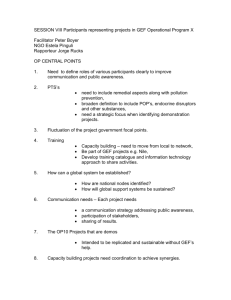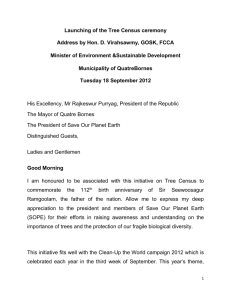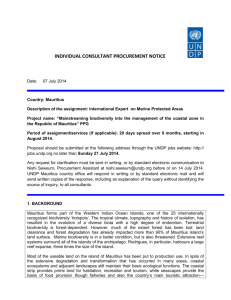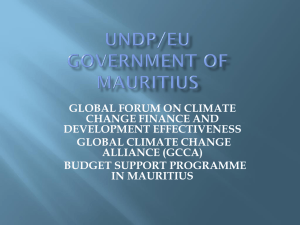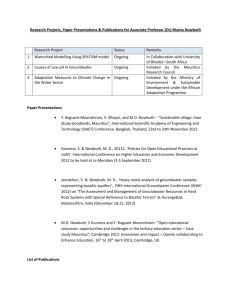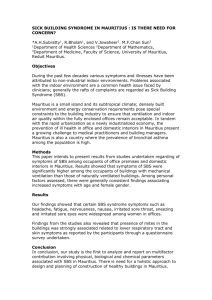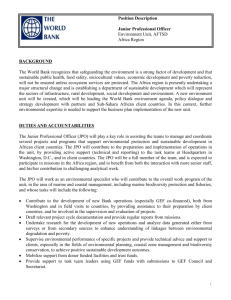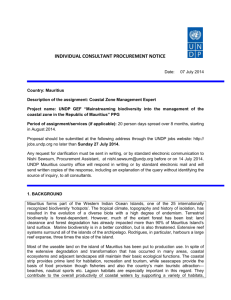Linkages between GEF priorities and National Priorities
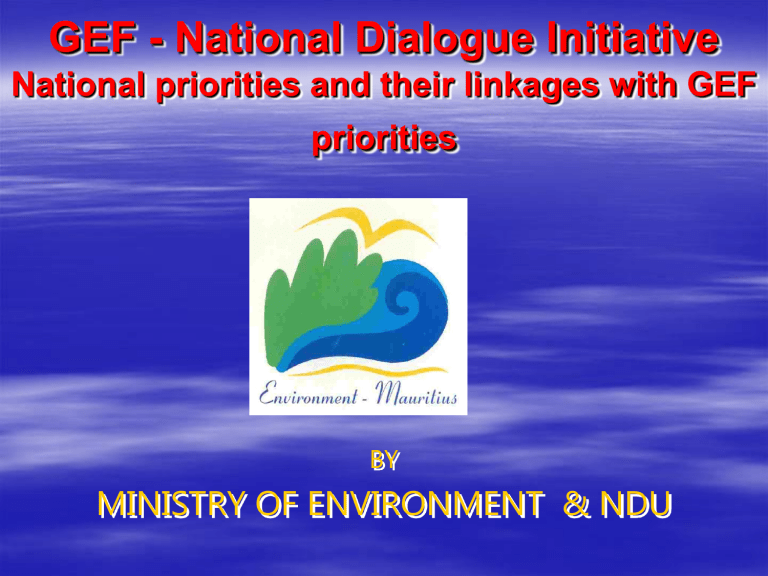
GEF - National Dialogue Initiative
National priorities and their linkages with GEF priorities
BY
MINISTRY OF ENVIRONMENT & NDU
AREAS OF CONCERN
o Land Resources o Air Quality o Water Resources o Coastal Zone o Biodiversity o Solid Wastes o Environment & Health & Technology
National Environmental
Action Plan (NEAP II)
prepared for the Government of Mauritius in
1999.
Implementation of the programmes started in 2000
Projects identified is completely financed by the Government of Mauritius
The NES is being updated and implementation of NEAP II is being reviewed
EIP 2
( 2000 ~ 2010 )
ENVIRONMENTAL INVESTMENT ~ 650 MILLION
RUPEES
SECTION A COMPLETED ( 9 )
Legislative Reform
Develop Environmental Indicators
Strengthen policy and strategic land planning at the central level
Islet recovery and restoration
National pest control strategy
Assisting planning in tourism zones, using site specific carrying capacity studies where appropriate
Assist in the development of a Local Plan for Rodrigues
Upgrade existing dump site
Improvement to waste collection and storage
SECTION B UNDER IMPLEMENTATION (37)
EIP Management Activities
Policy Development
Environmental Assessment
Develop Standards and Quality Objectives
Environmental Hotspots
Environmental Information System
NEL Capacity Building and Accreditation
Education and Awareness Training
Review land planning policies and enact planning legislation
Strengthen detailed planning and enforcement at the local level
Continue development of a land information system and demarcate sensitive areas
Institutional / legislative reform
Set up mobile air quality monitoring unit
Air quality monitoring system in Port Louis
Community involvement programme
Species recovery
Management of Black River National Park
Consolidate established marine parks and assess need for more reserves
Geomorphological shoreline analysis
Mapping using existing CASI imagery
Comprehensive monitoring programme
Institutional and legal review of Solid Waste Management
Make decision on long term final disposal, build consensus and undertake feasibility study and detailed design
Resource recovery and waste stream reduction
Management information system
Improve the links between tourism and the community and providing further recreation facilities for the public
Train pesticide users
Vehicle Emission Improvement
SECTION C BEING INITIATED (14)
Institutional Strengthening
Demarcating and Protecting Environmentally Sensitive Areas Public
Information Centre
Carry out an institutional review of land planning and implement its recommendations
Institutional reform
Water demand monitoring programme
Water resources monitoring programme
Ecological surveys
Establish a framework for ICZM
Establish the Mauritius Centre for Cleaner Production
Strengthen Control of the small-scale sector (including bungalows, guest houses, restaurants etc)
Invest in improvements in water resources
Improve wastewater management
Establish a marine reserve
SECTION D IN ABEYANCE (10)
Industrial Licensing and IPPC
Co-ordinate sectoral programmes
Institutional/legislative reform
Set up a revolving fund for industrial management
Plan future industrial development
Improve Public Involvement (Rodrigues )
Complete cadastral survey (Rodrigues )
Strengthen resources for local planning (Rodrigues )
Cost Recovery Charges (Ministry of Public Utilities )
1.
Loss of Biodiversity
2.
Damage to Coastal Zone
3.
Water (Quantity/ Quality)
430 million rupees/year
2000 million rupees/year
520 million rupees/year
4.
Solid Waste (Collection and disposal)
5.
Air Quality
760 million rupees/year
150 million rupees/ year
Overall Estimation 4 ~7 billion rupees/ year
Environmental Policy
Reconciling Economic Growth with Environmental Quality
Control of Pollution
Promotion of Clean Technology
Education & Public Awareness
Conservation of Resources
Protecting Local & Global Environment
NEW ENVIRONMENTAL POLICY(NEP)
The NEP identifies the following key environmental concerns :
land resources degraded by development pressures
Water resource management avoid water stress conditions
Air quality emissions from fossil fuels
ambient noise traffic congestion and industrial pollution
Biodiversity threatened by direct exploitation the resources, introduction of invasive alien species.
coastal zone beach erosion, loss of wetlands and coastal water pollution,
Solid waste management limited treatment and disposal facility
Public health threatened by environmental risks e.g. vector-borne diseases, improper use of pesticides and herbicides, etc
CONVENTIONS
Mauritius is a signatory to a number of international conventions concerning the environment :
Convention On Biological Diversity 1992
UN Framework Convention on Climate Change 1992
United Nations Convention to Combat Desertification
(UNCCD)
Convention On The Protection Of The Ozone Layer (Vienna)
1985 And Protocol On Substances That Deplete The Ozone
Layer (Montreal) 1987
Convention On The Prevention Of Pollution From Ships As
1973, As Modified By The Protocol Of 1978 (Marpol)
Convention On Wetlands Of International Importance
Especially As Waterfowl Habitat (Ramsar) 1971
Stockholm Convention on Persistent Organic Pollutants
(POPs)
GEF funded projects
Adapting Coastal Zone Management to Address the Impacts of Climate
Change: A demonstration for SIDS.
Removal of Barriers to Energy Efficiency and Energy Conservation in
Buildings in Mauritius
Preparation of Second National Communication under the UNFCCC
Support for the implementation of the National Bio-safety Framework
(NBF)
Building Capacity for Effective Participation in the Bio-safety Clearing
House (BCH).
Establishing a network of Private Protected Area
Partnerships for Marine Protected Areas in Mauritius and Rodrigues
Strengthening Capacity to Implement Global Environment
Conventions in Coastal Development in Mauritius (NCSA follow-up)
Sustainable Management of POPs in Mauritius.
Capacity Building for Sustainable Land Management for Mauritius
Addressing Land-Based Activities in the Western Indian Ocean (WIO-
LaB)
Southwest Indian Ocean Fisheries Project (SWIOFP)-M/fisheries
Linkages between national priorities and GEF priorities
GEF priorities
(i) CBD
Biosafety
Protected Area Network
Marine Protected Areas in Mauritius (MPA)and
Rodrigues
Mainstreaming
Biodiversity in Production
Landscapes/Seascapes
National priorities
(i) CBD
To complete the Islet
Management Plan phase
II)
Elaboration and formulation of projects under National Biodiversity
Strategy And Action
Plan(NBSAP)
GEF priorities
(ii) Climate Change
Energy-efficient buildings and appliances
On-Grid Renewable
Energy
facilitate GHG reduction through market transformation
National priorities
(ii) Climate Change
Rehabilitation of degraded beach
Using clean technologies in all sectors
GEF priorities
(iii) ozone
To guide in Phasing out of ozonedepleting substances
National priorities
(iii) ozone
700 kg of Methyl Bromide to be eliminated (financed under TPMP)
Cracking down illegal trade in CFCs
Hydrochlorofluorocarbons
(HCFCs) phase-out to be accelerated
GEF priorities
(iv) POPs
Sustainable
Management of POPs in Mauritius .
National priorities
(iv) POPs
to protect human health and the environment from
POPs
Results and Achievements
(i) CBD
Construction of release cages for Pink Pigeon
Construction of 4.9 ha CMAs
Construction of the Bird Breeding Centre
Islet Management Plan (phase I ) prepared
Two marine parks and six fishing reserves have been proclaimed
Indicators in relation to biodiversity have been identified. E.g. Loss of wetlands, Land use changes (Mauritius and Rodrigues), Ratio of endangered / threatened species to total species of flora and fauna etc.
NBSAP has been prepared and a series of project has to be implemented
(ii) Climate Change
Agricultural Sector
- Reafforestation programme, Plantation of mangroves, Monitoring of coral reefs
Energy Sectorraise awareness of industries on energy consumption
Results and Achievements
Transport Sector
Use of LPG in cars, reduction of sulphur content in diesel, Introduction of unleaded gassoline
Creation of Green Belt
-
Provision for green spaces has been included in the outline Scheme and in permits (EIA licences, morcellement permits )
Use of renewable energy-
Solar water heaters,Solar Photovoltaic,Electricity generation from coal and bagasse
(iii) Ozone phased out the use of CFCs
(iv) POP-NIP for pops under the Stockholm Convention completed and implementation initiated,POP chemicals are prohibited under DCCA.
Constraints or Challenges
FUNDING
NEED CAPACITY BUILDING /
TECHNICAL ASSISTANCE FOR
PROJECT FORMULATION &
ELABORATION
Lessons learnt
Strategies need to be developed in consensus with stake holders.
Ensure financial sustainability of projects.
Ensure active participation of stake holders.
There are many emerging environmental issues and action need to be taken urgently to protect the environment
Conclusion and Recommendations
Several projects are being implemented at the
Government level and are reflected in the
MTEF –programme Based Indicators
GEF support is required for elaboration and implementation of projects under different conventions
Establishment of funding mechanisms under each convention.
